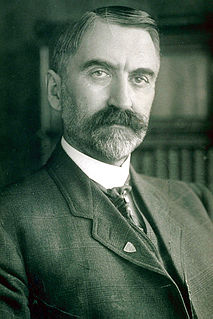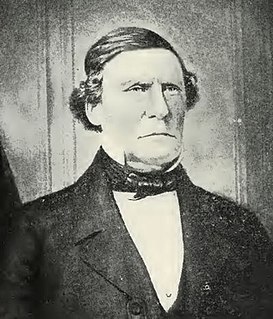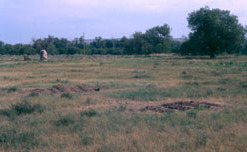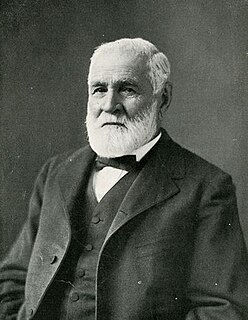
The Crow, whose autonym is Apsáalooke, also spelled Absaroka, are Native Americans living primarily in southern Montana. Today, the Crow people have a federally recognized tribe, the Crow Tribe of Montana, with an Indian reservation located in the south-central part of the state.

Fort Benton is a city in and the county seat of Chouteau County, Montana, United States. Established in 1846, Fort Benton is the second oldest continuously occupied settlement in Montana behind Stevensville, Montana. The city's waterfront area, the most important aspect of its 19th century growth, was designated the Fort Benton Historic District, a National Historic Landmark, in 1961.

Manuel Lisa, also known as Manuel de Lisa, was a Spanish citizen and later, became an American citizen who, while living on the western frontier, became a land owner, merchant, fur trader, United States Indian agent, and explorer. Lisa was among the founders, in St. Louis, of the Missouri Fur Company, an early fur trading company. Manuel Lisa gained respect through his trading among Native American tribes of the upper Missouri River region, such as the Teton Sioux, Omaha and Ponca.

The American Fur Company (AFC) was founded in 1808, by John Jacob Astor, a German immigrant to the United States. During the 18th century, furs had become a major commodity in Europe, and North America became a major supplier. Several British companies, most notably the North West Company and the Hudson's Bay Company, were eventual competitors against Astor and capitalized on the lucrative trade in furs. Astor capitalized on anti-British sentiments and his commercial strategies to become one of the first trusts in American business and a major competitor to the British commercial dominance in North American fur trade. Expanding into many former British fur-trapping regions and trade routes, the company grew to monopolize the fur trade in the United States by 1830, and became one of the largest and wealthiest businesses in the country.
Fort Kiowa, officially Fort Lookout and also called Fort Brazeau/Brasseaux, was a 19th-century fur trading post located on the Missouri River between modern Chamberlain, South Dakota, and the Big Bend of the Missouri.

Hiram Martin Chittenden was an American engineer and historian. A graduate of West Point, he was the Seattle district engineer for the Army Corps of Engineers from 1906 to 1908). Chittenden was one of the first three elected Port Commissioners at the Port of Seattle. He also helped found the Pacific Coast Association of Port Authorities, later known as the Association of Pacific Ports in 1913. The Hiram M. Chittenden Locks in Seattle are named in his honor.
The Missouri National Recreational River is a National Recreational River located on the border between Nebraska and South Dakota. The designation was first applied in 1978 to a 59-mile section of the Missouri River between Gavins Point Dam and Ponca State Park. In 1991, an additional 39-mile section between Fort Randall Dam and Niobrara, Nebraska, was added to the designation. These two stretches of the Missouri River are the only parts of the river between Montana and the mouth of the Missouri that remain undammed or unchannelized. The last 20 miles of the Niobrara River and 6 miles of Verdigre Creek were also added in 1991.

Kenneth McKenzie was nicknamed the "King of the Missouri", for as a fur trader for American Fur Company in the upper Missouri River valley, he controlled a territory larger than most European nations.
Fort Lisa (1812–1823) was established in 1812 in what is now North Omaha in Omaha, Nebraska by famed fur trader Manuel Lisa and the Missouri Fur Company, which was based in Saint Louis. The fort was associated with several firsts in Nebraska history: Lisa was the first European farmer in Nebraska; it was the first settlement by American citizens set up in the then-recent Louisiana Purchase; Lisa's wife was the first woman resident of European descent in Nebraska; and the first steamboat to navigate Nebraska waters, the Western Engineer, arrived at Fort Lisa in September 1819.

Pierre Chouteau Jr., also referred to as Pierre Cadet Chouteau, was an American merchant and a member of the wealthy Chouteau fur-trading family of Saint Louis, Missouri.

Fort Pierre Chouteau, also just Fort Pierre, was a major trading post and military outpost in the mid-19th century on the west bank of the Missouri River in what is now central South Dakota. Established in 1832 by Pierre Chouteau, Jr. of St. Louis, Missouri, whose family were major fur traders, this facility operated through the 1850s.

Snowden Bridge is a high-clearance, vertical-lift railroad bridge, built in 1913, that spans the Missouri River between Roosevelt and Richland Counties in Montana, USA, between Bainville and Fairview, Montana, and near Fort Union Trading Post National Historic Site and the ghost town of Mondak near Montana's eastern border with North Dakota. Snowden Bridge is a near twin of the Fairview Bridge, which crosses the Yellowstone River in North Dakota, both bridges having been built by Montana Eastern Railway within 10 miles (16 km) of each other over different rivers in different states.
The Missouri Fur Company was one of the earliest fur trading companies in St. Louis, Missouri. Dissolved and reorganized several times, it operated under various names from 1809 until its final dissolution in 1830. It was created by a group of fur traders and merchants from St. Louis and Kaskaskia, Illinois, including Manuel Lisa and members of the Chouteau family. Its expeditions explored the upper Missouri River and traded with a variety of Native American tribes, and it acted as the prototype for fur trading companies along the Missouri River until the 1820s.

Pierre-Jean De Smet, also known as Pieter-Jan De Smet, was a Flemish Catholic priest and member of the Society of Jesus (Jesuits). He is known primarily for his widespread missionary work in the mid-19th century among the Native American peoples, in the midwestern and northwestern United States and western Canada.
This timeline of South Dakota is a list of events in the history of South Dakota by year.
Columbia Fur Company was a fur trading and Indian trading business active from 1821 to 1827, in Michigan Territory and in the unorganized territory of the United States. It then became the Upper Missouri Outfit of the American Fur Company.

Alexander Culbertson (1809–1879), was an American fur trader who founded Fort Benton, Montana, and was a special government agent who played an important role in the negotiations leading to the 1851 treaty of Fort Laramie. Later, Culbertson and his wife Natawista Iksina negotiated with the Blackfoot Confederacy to let the northern Pacific railroad survey of 1853 continue unharmed.

Joseph Marie LaBarge was an American steamboat captain, most notably of the steamboats Yellowstone, and Emilie, that saw service on the Mississippi and Missouri rivers, bringing fur traders, miners, goods and supplies up and down these rivers to their destinations. During much of his career LaBarge was in the employ of the American Fur Company, a giant in the fur trading business, before building his own steamboat, the Emilie, to become an independent riverman. During his career he exceeded several existing speed and distance records for steamboats on the Missouri River. Passengers aboard his vessels sometimes included notable people, including Abraham Lincoln. LaBarge routinely offered his steamboat services gratis to Jesuit missionaries throughout his career.
The Spread Eagle was a steam-driven sidewheel riverboat that transported passengers, goods and supplies to the forts and trading posts along the Missouri River between 1857–1864. It was constructed and launched at Brownsville, Pennsylvania. The vessel was a wooden hull packet, 210 feet long, with a beam of 36 feet, a draft of 6 feet, and was rated at 389 tons. It was powered by two steam engines with 3 boilers each, at 40 inches in diameter and 24 feet in length. The Spread Eagle was constructed by Captain Benjamin Johnson who sold the vessel to the American Fur Company upon her arrival at St. Louis. Commanded by captain Bailey, she was once engaged in a race along the Missouri from St. Louis to Fort Benton where she rammed her opponent.
The Emilie was a sidewheel steamer, designed, built and owned by the famed riverboat captain Joseph LaBarge, and used for trade and transporting people and supplies to various points along the Missouri River in the mid nineteenth century. The Emilie was built in Saint Louis in 1859, was 225 feet in length with a 32 foot beam and had a draft of six feet. Larger than the average riverboat at the time, she could carry 500 tons of cargo. During her extended service on the Missouri River she also fell into the hands of both Union and Confederate soldiers during the Civil War. As a result of her numerous exploits, Emilie was among the most famous boats on the river and was widely considered a first rate and an exceptionally beautiful riverboat. After some nine years of service the Emilie was caught in and destroyed by a tornado on June 4, 1868.















